#HS code packaging material
Explore tagged Tumblr posts
Text
Import Aluminum Foil Rolls
Step-by-Step Import Guide: Aluminum Foil Rolls to Jakarta (HS 7607.11) 🏗️ Why Aluminum Foil Rolls Require Precision in Import? Aluminum foil used in packaging, cable insulation, and food manufacturing is classified under HS Code 7607.11. Imports into Jakarta are often flagged due to unclear specifications or incorrect HS coding. Let us walk you through the correct steps to avoid costly…
#aluminum foil import Jakarta#aluminum foil Indonesia#foil roll clearance#freight forwarder Jakarta#freight forwarding Indonesia#HS 7607 Indonesia#HS code packaging material#Jakarta freight forwarder#Jakarta import foil#PIB import packaging
0 notes
Text
Import Aluminum Foil Rolls
Step-by-Step Import Guide: Aluminum Foil Rolls to Jakarta (HS 7607.11) 🏗️ Why Aluminum Foil Rolls Require Precision in Import? Aluminum foil used in packaging, cable insulation, and food manufacturing is classified under HS Code 7607.11. Imports into Jakarta are often flagged due to unclear specifications or incorrect HS coding. Let us walk you through the correct steps to avoid costly…
#aluminum foil import Jakarta#aluminum foil Indonesia#foil roll clearance#freight forwarder Jakarta#freight forwarding Indonesia#HS 7607 Indonesia#HS code packaging material#Jakarta freight forwarder#Jakarta import foil#PIB import packaging
0 notes
Text
Review: Bandai S.H.Figuarts Shinkocchou Seihou Kamen Rider 1 and Cyclone 1 (THE NEXT Ver.)+Bonus Part. 01

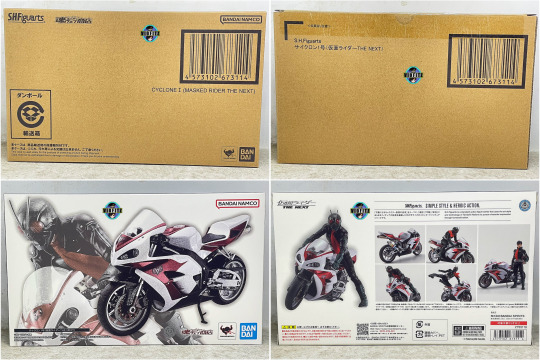
Introduction:
Bandai S.H.Figuarts (SHF) is a popular line of high quality collectable figures made by Bandai. The toyline debuted in 2008 and is targeted towards the adult fans of the series with its higher price and show-accurate detailing of the figurines. The line started in Kamen Rider THE NEXT series and has expanded to many franchises. In this review, it will focus on Kamen Rider THE NEXT again after their long release, they finally renewed their first figure which Kamen Rider 1 (Ichigo) a.k.a. Takeshi Hongo and his motorcycle Cyclone 1 in Shinkocchou Seihou line to celebrate total 100 released figures of this line. This series uses one of S.H.Figuarts's new ways of manufacturing figures to powerful action, the dynamics of that soul reproduced in the palm of your hand, SHINKOCCHOU SEIHOU is a process that starts from the skeleton instead of the surface and pursues both the original presence of the hero and the natural movement of the figure. Well, this means this line is focusing on making a realistic proportions and following how the actual source materials more intense than the regular SHF line. So far they focused on Kamen Rider series then followed by a few Super Sentai releases, this will be my very first review of this toy line since I haven't got a chance to review any SHF SS figure until now. Although, Ichigo THE NEXT isn't my first SS figure since I got SHF SS Kamen Rider BLACK and ShadowMoon but, I'm not happy with those two since they felt too fragile to handle and what's worse they got one of the worst QC issues from most of reviewers. Therefore I refrained myself on reviewing BLACK and ShadowMoon and there's another particular reasons why but, I do not want to mention it. Okay, from packaging themselves, both Ichigo and Cyclone is unfortunately a Premium Bandai releases so, they're included with that dirty brown case. While his main packaging, he was packaged with removable styled boxart, which was divided into 2 part; box for figure contents and a cover for the inner box. Similar like a smartphone boxart, which I hate it so much because I can't see the contents to inspect the QC issue. Thankfully, there's no big issue on my Ichigo so far, the same goes to Cyclone 1 which seems to be okay to my eyes atleast. Despite made for SHF SS but, they don't have their own specific name since they're still only considered as SHF Cyclone 1. They're packaged very similar to the old class SHF EX but, with SS styled boxart design. Both Ichigo inner rear and Cyclone 1 rear boxarts were also featuring the figure's capabilities and their required accessories in their promotional photos. Seems to me, they're only exclusive to P-Bandai Japan since there's no other regional releases as far as I seen, though not sure for those like in the China.

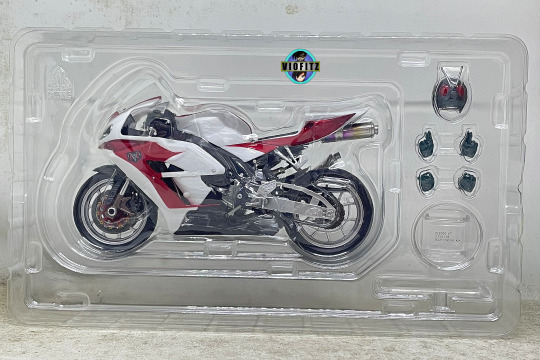
Contents:
Out of the box, Ichigo comes with his main figure, Takeshi Hongo head sculpt (HS), 3 pair of option hands and a pair of preassembled spare antennas. While Cyclone 1 comes with the main bike figure, mouthless Ichigo helmet, 2 pair of option hands and 2 bike stands.

Character introduction:
Takeshi Hongo is one of the two main protagonists of Kamen Rider. He is a young student who was kidnapped by Shocker and turned into a Cyborg/Remodeled Human, unlike the main series he was briefly brainwashed and active as Code-named "Hopper" until he reclaimed back his sense of humanity, which later betrayed Shocker and deciding to use his powers for good as the Kamen Rider. in THE NEXT movie, he is a returning character which he is working as a science teacher in a Japanese high school but, get involved again with Shocker. Having a fascination with science, Hongo is shown to greatly appreciate the beauty of life, expressing it in his study of snowflakes. He also harbored a crush on Asuka, but expressed her finding happiness in her upcoming marriage with Katsuhiko. When mind-controlled by Shocker, Hongo became a ruthless figure, until breaking free after remembering his admiration of snowflakes, deciding to oppose Shocker's evil as the Kamen Rider. Hongo relies mostly on his superhuman in physical prowess which fights bare handed, in this incarnations he is never seen using any weapon. His only weapon used was rather his own motorcycle Cyclone 1 which he always using his Cyclone's speed to power up his Rider Kick attacks. Cyclone 1, is a high-performance motorcycle ridden by Hongo and its base model from Honda CBR1000RR. Unlike the original, in Kamen Rider The First, the bike was designed and created by his mentor Tobei Tachibana. Tachibana seemingly had long been known with Hongo since he's seemingly impressed with Hongo's motorbike skills, and the bike was given a special tune-up. Its extraordinary performance was a great help to Hongo in his battle against Shocker. It has speed of up to 400km per hour, it is durable enough to withstand a body ramming into a motorcycle ridden by a Shocker Combatant or even Shocker Rider, and is stable enough that it will not tip over even if Hongo stand on it while it is moving. It has extremely high specs, including the ability to run underwater and even jump out of the water.



In "THE NEXT" representation, Ichigo's suit in here was depicted to have more sleek looking like a biker compared to main counterpart. He appeared to have darker color tone than his "THE FIRST" appearance as a sign of the fierce battle, his rider suit has changed since it was worn two years ago, with the color of his chest armor, gloves, boots, and mask now a dark dull blue to green-ish, and his glow-in-the-dark eyes, which used to be pink, now turns into a bright red. Also, there used to be inconspicuous black lines on the sides of his body and on his arms, but now they're changed into double dark dull blue green-ish lines engraved into them. Unlike the old version, his gloves and boots nolonger have metallic paintapp anymore. While undoubtedly agree the renewal outclassed the old version but, sadly this Ichigo still lacking something and even there's a tiny bit of missing design on his suit. But, I won't be mentioning this since it's something minor and barely noticeable but, I'd rather let you to see for yourself by looking at my photoshoots and see if you can tell which part that I mean. From here, I'll be focusing on his mobility on his articulation works. SHF SS articulations supposed to be working even better than your standard SHF figure. So far he got over 35 points of articulation in total, which is the same like his old version but, with updated technology of using SS carving. So far, the mobility of his articulations does indeed worked better than his old version but, there're some part that is hard to execute or I'm just not used to playing this SS figure since I'm not really fond with their price point. But, atleast you got what you paid and what you expected to have a total movie accurate, whenever I posed this Ichigo he's looking very dynamic and alive like how he looks in the movie despite all that visible joints. His scarf is made from wired fabric which allows us to adjust their position for expressive posing purposes, though... I'm not really fond with their obvious different materials between the tied plastic choker and that fabric loose parts. His butterfly joints can go up as close to his head but, he cannot cross his arms lower like how the old version did due to limited butterfly joints. His legs however, can move very dynamic and long range of mobility and there're few part that surprised me as well that allows me to make his posing looking more dynamic such as thighs and knees swivel. Though, posing him riding his Cyclone proved to be a bit challenging to me since, I had a hard time making him to actually sit on the saddle. And I'm always wary of myself if I accidentally breaking them since this SS line is known for their frailty compared to the standard releases. Seriously, if only Bandai did not charged him way too much, I'd have more guts to take the risks.


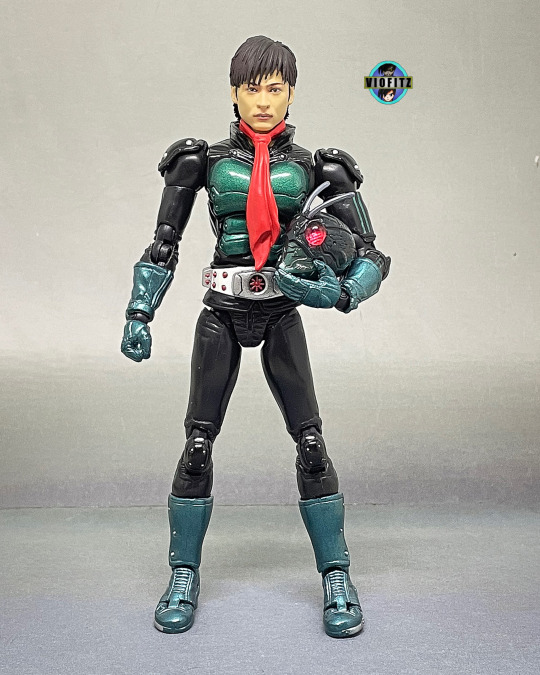
Ichigo's grasshopper shaped mask appeared to have battle damaged like small scratches and dents as a result of his fierce battles he had been through during his time on the run since. However, despite this looks... His sculpted helmet feels smooth as there's no scratches or something protruding, it seems like that battle damaged effects were simply digital painted. This is contrast to the old version which they sculpted an actual sculpted battle damaged on his helmet, not that I dislike the smooth feel but, gotta say that painted effects kinda did the trick. His helmet also comes with rear lower hair part for showing Hongo's hair. The antennas are removable so, if you ever miss then you can use it's spare for backup. Aside mask/helmet, he also comes with Takeshi Hongo HS, which feature Masaya Kikawada actor. I gotta say, this Hongo HS got the actor's likeness accurately which he is shown with neutral serious expression and interestingly, his head can be cast-off into 4 parts; faceplate, fringe, upper rear hair and lower rear hair. Not sure why they did this but, it could be a hint for future release where they'll renew Ichigo THE FIRST, they'll probably also include him with another Hongo HS that would probably face swappable. However, this cast-off parts atleast kinda helped me for making some extra stuff for him, it'll be a bonus for this review. And another interesting part, Hongo's HS also fit to the older version of Ichigo THE NEXT body. With Cyclone 1, he also comes with mouthless mask/helmet for his unmasked scene. The overall sculpt and paintapp and even removable antennas is the same like Ichigo's helmet but, made to be hollow and missing it's mouth plate. It's a little bummer this helmet isn't wearable even for Hongo's faceplate, I was hoping to recreate Hongo HS wearing this helmet that reveals his mouth like in THE FIRST movie.
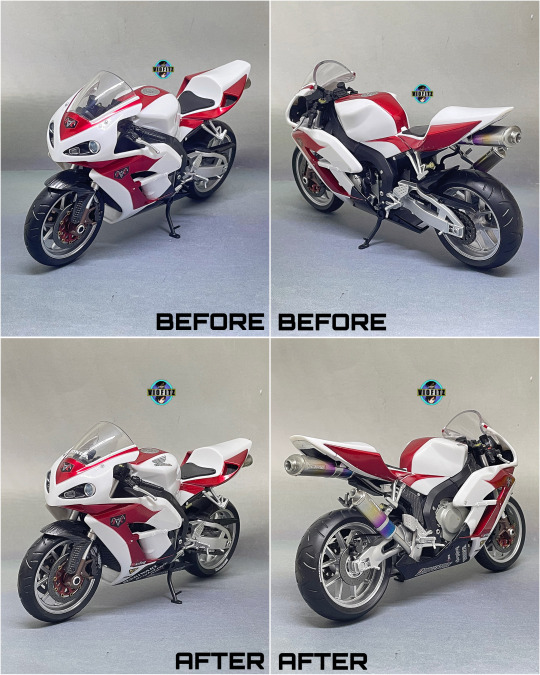
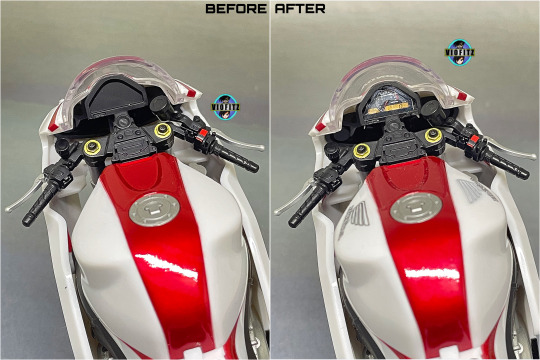
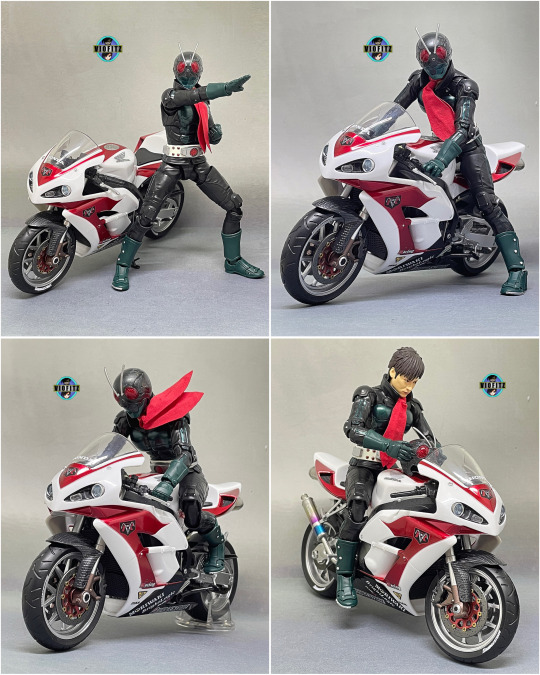
Cyclone 1 was designed to be more like a racing motogp instead of the usual Kamen Rider motorcycle which got their own unique modifications. Its overall body color consisted metallic maroon red, white and black for underneath body part. Its exhaust is rainbow colored and the inner parts are mostly black and silver with some red and bronze color on the front spokes. The design may have changed for modern looks (atleast back in 2005) but, made to be more realistic looking without any distinctive part of being a Kamen Rider motorcycle. Its design remained the same from "THE FIRST" to "THE NEXT" movies without any change at all so, if you miss this one you can just use the old version for alternative. Originally, this Cyclone's figure is lacking it's livery sponsors which, I personally unhappy with it because it feels like it has no different to it's older version which already missing those sponsors. I can understand of the licensing issues but, this is for SHF SS so it had to have that exact looks. However, I asked my friend to implement that missing sponsors including its speedometer and now, my Cyclone is now looking movie accurate. There're changes between the old version but, I'm not gonna point out one by one since it'll make this review too long. But, one thing that differ them by physic is the renewal one is very lighter than the old version.
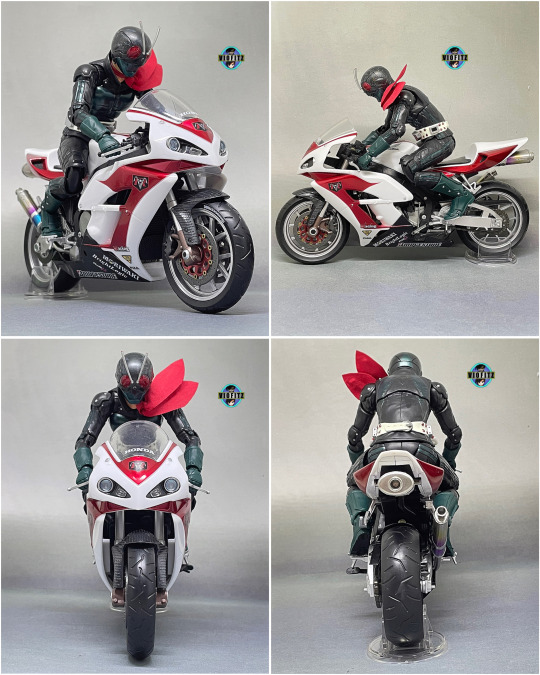
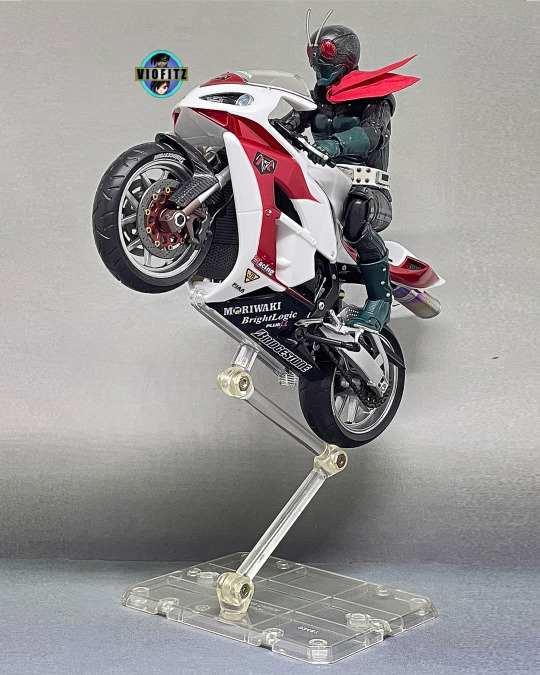

Cyclone also comes with alternate stand for maintaining its position without sidestand, this is mainly used for Ichigo for either riding or Rider Kick pose or even standing on Cyclone. Interestingly, it also comes with stage act piece for jumping pose, there're atleast 2 scenes involving where Cyclone jumping but, only in THE FIRST movie. I gotta say, it's a very nice addon despite they never actually show a jumping pose even in the promotional photo but, deattaching the stand piece is a little troublesome so, I won't be using this again for future pose.
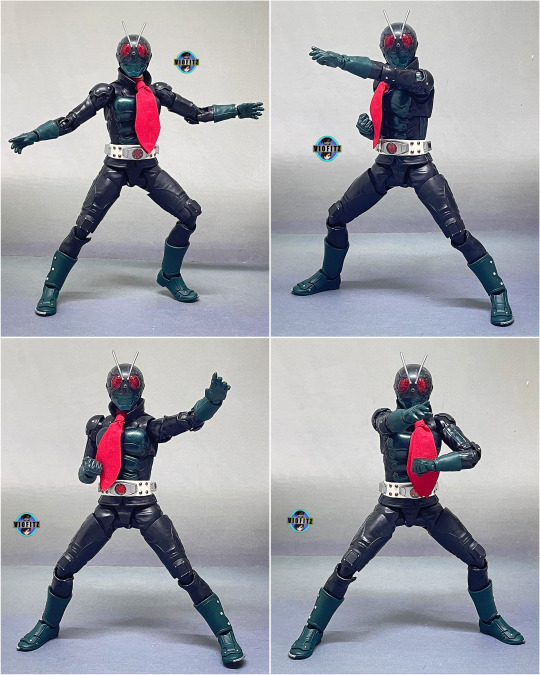


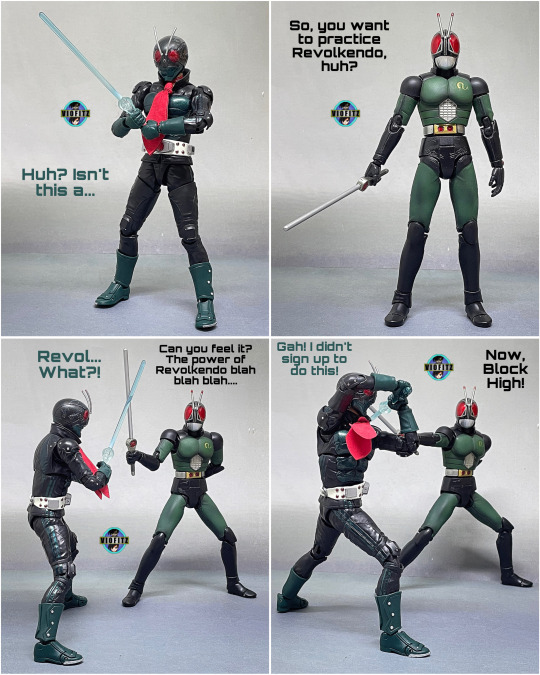

Ichigo comes with 8 interchangeable hands but, with Cyclone 1 he gets 12 hands in total that would be: a pair of relaxed open hands which already attached to the main figure for his relaxed pose or certain Henshin or battle pose, a pair of fisted hands for battle stance or Rider Punch pose, a pair of open splayed hands for various poses, a pair of chopping hands for recreating his Henshin sequence pose, a pair of grasping hands for gripping Cyclone's handgrip, and a pair of grasping hands with 2 fingers gestures for handling the Cyclone's clutches. I like how Bandai generously gave him these amount of hands, albeit you'll have to buy Cyclone for another 4 hands. Well, the positive thing of these hands are not only being more than convenient enough for recreating various poses but, the sculpting of his hands are looking realistic as well, whatever hands I uses, Ichigo's hand posing looked so fitting.
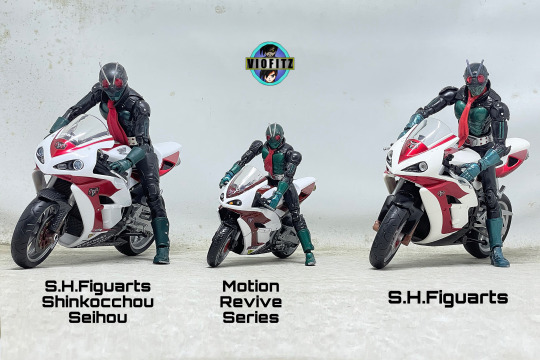
Comparisons:
Comparing between old SHF Ichigo THE NEXT and SHF EX Cyclone THE FIRST and even Motion Revive Series (MRS) Ichigo THE NEXT and my customized Cyclone 1, the SHF SS outclassed them all in terms of quality and moldings but, when it comes to durability, old versions still holds since there's no frail part such as hard plastic spikes or antennas. Tbf I still love the old one since it's easier to pose, the same goes to MRS one but... All 3 of them still got their own charms for me.


Bonus: Custom S.H.Figuarts Takeshi Hongo
The bonus for this review is none other than a stand alone Custom SHF Takeshi Hongo! In this custom recreation, Hongo uses SHF Shin Dan Kuroto's body, which skin tone is repainted to fit with Hongo's HS skin tone. As well as his undershirt repainted into white to fit with Hongo's suit design in THE FIRST movie. His overall getup is black jacket, white undershirt, black pants and black double monk strap shoes. And the good thing that their heights also stands equally. The figure's articulations works much the same like Bandai's civillian SHF which, appeared to have limited articulation in several part, that is; single jointed elbow and knees. So far, Hongo got 20 points of articulation. Well, SHF Shin Dan Kuroto is quite an old release so, not to be expected much but, atleast he can still pull it off to recreate Hongo's poses. Mainly also works for riding Cyclone.

Contents:
He comes with 2 wearable custom made helmets that he wore in THE FIRST and THE NEXT movies and one pointy finger right hand for recreating Hongo to be more heroic feel like his main counterpart when shouting to Shocker. Actually Dan Kuroto comes with more hands but, I'm gonna use other hands from other random SHF figures, specifically grasping hands for riding Cyclone.
END OF PART. 01
#action figures#toys#toy review#review#bandai#bandai namco#sh figuarts#Sh figuarts shinkocchou seihou#Shinkocchou seihou#kamen rider ichigo#kamen rider#takeshi hongo#Masaya kikawada#kamen rider the first#Kamen rider the next#Bandai#tamashii nations#Bandai spirits
0 notes
Text
Shipping to Malaysia from Australia: Key Customs Guidelines to Know
Shipping a parcel to Malaysia from Australia is easier than ever, thanks to global courier networks and efficient customs processes. However, clearing Malaysian customs still involves certain regulations, documentation, and duties that senders must be aware of. Whether you're a business owner sending merchandise or an individual sending a care package, understanding these customs guidelines is crucial to avoid unnecessary delays, extra costs, or rejected shipments.
In this blog, we’ll walk you through the most important customs guidelines and practical tips for shipping to Malaysia from Australia, including what you can send, what you should avoid, and how to ensure smooth customs clearance.
1. Understanding Malaysian Customs Regulations
When you send a parcel to Malaysia, it goes through the Royal Malaysian Customs Department for clearance. This process involves verifying the contents of the package, ensuring the correct duties and taxes are applied, and checking for restricted or prohibited items.
Malaysia follows the Harmonized System (HS Code) for classifying goods, which helps determine the customs duty applicable. Be honest and specific in describing the contents of your parcel—vague terms like “gifts” or “personal items” may result in inspection delays.
2. Required Documentation for International Shipments
Proper documentation is the first step toward hassle-free shipping to Malaysia from Australia. The key documents typically required include:
Air Waybill (AWB): Provided by your courier, this contains sender and recipient info, tracking, and shipping method.
Commercial Invoice or Proforma Invoice: Lists the contents, quantity, value, and purpose of shipment (e.g., sale, gift, sample).
Packing List: Sometimes requested, especially for larger commercial shipments.
Import Permits (if applicable): For items such as electronics, medicines, or food products.
Always ensure the information is accurate and consistent across all documents.
3. Duties and Taxes on Shipments to Malaysia
Malaysia levies import duties and taxes on most goods arriving from overseas. The customs duty rate varies depending on the item and its declared value. In addition to duties, Malaysia applies a Sales and Service Tax (SST) on imported items, which is currently set at 5% or 10%, depending on the product category.
Shipments below a certain threshold (RM 500 for courier services, subject to change) may be exempt from duties and taxes. However, these exemptions can vary, so it’s best to check with your courier or a customs agent before shipping.
4. Prohibited and Restricted Items
Malaysia has a clear list of items that are either prohibited or restricted. Prohibited items cannot be imported under any circumstances, while restricted items may require licenses or approvals. Here are a few examples:
Prohibited:
Narcotics and controlled substances
Pirated media and counterfeit goods
Firearms and explosive materials
Obscene or indecent materials
Restricted (require prior approval):
Prescription medications
Alcohol and tobacco products
Live animals or plants
Communication devices and drones
Before sending a parcel to Malaysia, consult your courier or the Malaysian customs website for the most updated list of restricted items.
5. Packaging and Labeling Best Practices
Customs authorities pay close attention to how items are packed and labeled. Use durable packaging that can withstand long transit times, and avoid any misleading labels.
Label each item clearly and provide a detailed description on the invoice. If you're sending electronics, mention the make, model, and serial number. For food items, include details about ingredients and expiry dates.
Proper labeling speeds up the customs process and reduces the risk of your shipment being held or rejected.
6. Choosing a Reliable Courier Partner
The success of shipping to Malaysia from Australia greatly depends on the courier service you choose. A trusted courier like DTDC Australia not only ensures timely delivery but also helps manage customs paperwork, declarations, and compliance.
DTDC provides real-time tracking, dedicated support, and expert guidance on international shipping regulations. Whether you're sending personal belongings, documents, or commercial goods, DTDC makes the process seamless.
7. Timeframes and Delivery Expectations
Delivery timelines can vary depending on the courier service, destination within Malaysia, and customs clearance duration. Typically, express couriers deliver parcels within 3–5 business days, while standard services may take 7–10 business days.
Delays may occur during Malaysian public holidays or due to incorrect/incomplete documentation. Plan ahead and provide accurate details to avoid any unnecessary holdups.
8. Tips for Smooth Shipping Experience
Here are a few final tips to ensure your parcel reaches Malaysia safely and on time:
Double-check the recipient’s full address, contact number, and postcode.
Declare items honestly to avoid fines or penalties.
Attach a copy of the invoice on the outside of the package (in a pouch or envelope).
Avoid shipping items close to Malaysian festivals or peak seasons unless using express services.
Insure your parcel if it contains high-value goods.
What About Shipping from Malaysia to Australia?
If you’re curious about shipping from Malaysia to Australia, similar rules apply. Senders in Malaysia must comply with Malaysian export regulations and Australian import laws. Customs duties may apply on certain items, and specific documentation will be needed.
Whether you’re sending gifts, samples, or business consignments, choosing a reliable courier and understanding both countries’ customs procedures is essential for successful shipping.
Conclusion
When it comes to shipping to Malaysia from Australia, staying informed about customs guidelines can make all the difference. From documentation and duties to restricted items and packaging, every step counts in ensuring your parcel arrives safely and promptly.
With expert support from trusted courier partners like DTDC Australia, you can ship confidently, knowing your parcel is in good hands. Whether it’s a personal gift or a business delivery, smooth customs clearance starts with the right knowledge and preparation.
0 notes
Text
Polyester Industry Insights: Recycling, Fiber Production, and Market Trends Shaping 2025

As sustainability and innovation reshape the textile and chemical industries, polyester remains a cornerstone material—thanks to its durability, versatility, and recyclability. From polyester fabric recycling to the rising demand in polyester staple fiber and polyester polyol markets, the polyester landscape is evolving rapidly. This blog explores key trends, market movements, and production insights across various polyester products, providing an overview tailored for industry leaders, manufacturers, and market watchers.
The Rise of Polyester: Fiber, Resin & Polyols
Polyester, a synthetic polymer derived from petroleum-based raw materials, dominates textile and plastic applications globally. A wide range of products, from polyester fiber and polyester resin to polyester polyols, are reshaping industries including apparel, automotive, construction, and packaging.
In particular, polyester fiber from PET bottles is gaining attention as sustainability pressures increase. Recycled PET (rPET) enables a circular economy in the textile value chain, reducing dependence on virgin resources.
Polyester Fiber Market & Manufacturing Process
The polyester fiber market is expanding significantly due to its growing use in home textiles, automotive interiors, apparel, and geotextiles. Polyester fibers are categorized as polyester staple fiber and filament fiber, with staple fibers mimicking the properties of natural cotton.
Polyester fiber market is estimated at USD 102.2 billion in 2023 and is projected to reach USD 151.6 billion by 2028, at a CAGR of 8.2% from 2023 to 2028.
Key production stages involve:
Polymerization of PET chips
Melt spinning
Drawing and cutting
These steps form the backbone of the polyester fiber production process and are crucial for achieving consistent fiber strength and quality.
Countries like Vietnam and Indonesia are emerging as global hubs. A polyester staple fiber manufacturer in Vietnam or a polyester staple fiber manufacturer in Indonesia can offer cost-effective, high-volume production with growing export capacity.
Polyester Fabric Recycling & Circular Initiatives
Polyester fabric recycling has become a vital sustainability strategy. Recycling methods—such as mechanical recycling of clear PET bottles and chemical depolymerization—are helping industries meet environmental compliance and reduce landfill waste.
Polyester recycle trends are being shaped by innovations in sorting technology, closed-loop manufacturing, and growing consumer demand for eco-friendly fabrics.
Polyester Polyols and Their Expanding Market
Polyester polyols—crucial raw materials for polyurethane production—are now widely used in adhesives, flexible foams, and automotive coatings. The polyester polyol market is gaining traction due to increased demand in construction and furniture sectors.
With a dedicated HS code, polyester polyol manufacturers are scaling production across Asia, Europe, and North America. The polyester polyols market is being driven by the adoption of sustainable building practices and automotive light-weighting strategies.
Polyester Resins: From Unsaturated to Versatile Applications
Polyester resin, particularly unsaturated polyester resin, is used in composites, marine components, and electrical insulations. The polyester resins market is forecasted to grow steadily, driven by its thermosetting properties, low shrinkage, and excellent mechanical performance.
Manufacturers are expanding their polyester resin product lines for niche applications like FRP (fiber-reinforced plastics) and specialty coatings.
Polyester Film & Powder Coating Applications
Beyond fibers and resins, polyester film holds significant value in the packaging and electronics industries. The polyester film industry in India, in particular, is booming due to rising demand in flexible packaging and solar panel backsheet production.
Polyester powder coating offers corrosion resistance and weatherability, making it ideal for architectural applications. These coatings are solvent-free and eco-friendly, aligning with current green manufacturing trends.
Market Outlook and Pricing Trends
The polyester market size is projected to experience robust growth, driven by global demand for synthetic fibers, recycled PET, and polyurethane applications. Competitive polyester pricing across Asian markets is also enabling greater accessibility for manufacturers and consumers alike.
Industry experts are closely tracking:
PET resin fluctuations
Government regulations on plastic usage
Shifting demand between staple fiber and filament fiber
Global Supply Chain & Regional Growth Hubs
Asia-Pacific dominates the polyester manufacturing landscape, with China and India as key players. The polyester manufacturing process—available in detail through industry whitepapers and PDF resources—requires advanced technology for polymerization, extrusion, and finishing.
From polyester yarn production process to polyester staple fiber production, scalability and automation are critical for meeting international quality standards and delivery timelines.
Download PDF brochure for deeper insights :
From production to recycling, the polyester value chain is undergoing a dynamic transformation. Whether it's the expanding polyester fiber market, innovative polyester resin products, or sustainable polyester polyol solutions, the future of polyester is increasingly driven by circularity, technology, and global collaboration. As a global material with local impacts, polyester continues to be a focal point of innovation and growth—across fibers, resins, films, and coatings. Businesses that adapt to market trends, optimize their polyester production process, and invest in recycling infrastructure will be well-positioned to lead the next phase of sustainable material development.
#Polyester Fiber#Polyester Staple Fiber#Polyester Fabric Recycling#Recycled PET Fiber#Polyester Polyol#Unsaturated Polyester Resin#Polyester Market Trends
0 notes
Text
India’s Booming Wood Export Industry: Trends, Data & Exporters to Watch

India, with its vast forest resources and varied climate zones, is home to an incredible diversity of tree species. This richness gives the country a competitive edge in the global wood trade. From tropical hardwoods to temperate conifers, India is carving out a significant place in the international market. Let’s delve into how wood export from India is growing, who the major players are, and which countries are importing Indian timber in large volumes.
India’s Forest Wealth and Timber Production
India’s forests are a mix of tropical, subtropical, deciduous, evergreen, and coniferous zones. These ecosystems contribute to the country’s thriving wood industry. Each year, India produces about 400 tons of sandalwood, making it the world's largest producer of this valuable aromatic wood.
Other popular woods produced in India include:
Teak
Rosewood
Mahogany
Sal
Mango Wood
Sheesham (Indian Rosewood)
Deodar
Satinwood
Cedar
In the 2023–2024 period, India generated around 102 million cubic meters of small-sized wood, worth approximately INR 482 billion. An additional 37 million cubic meters of medium- and large-sized timber, valued at INR 359 billion, was also harvested. These figures reflect the immense scale of India’s domestic wood production.
The Indian wood market is projected to grow from USD 14.77 billion in 2024 to USD 22.5 billion by 2029, supported by an impressive CAGR of 8.78%. Key growth factors include rising demand from the construction, packaging, and paper industries.
Global and Indian Wood Market Outlook
Globally, the wood market stood at USD 236 million in 2022 and is expected to reach USD 389.6 million by 2029. India’s wood sector is outpacing this growth with its stronger CAGR.
Key Drivers Behind Wood Export Growth
Population Growth: Higher demand for construction and furniture materials.
Industrial Expansion: Growing sectors like packaging and construction rely heavily on wood.
Sustainability Trends: Innovation in eco-friendly wood products fuels exports.
Economic Development: Rising incomes lead to higher consumption of wooden goods.
However, these trends also create concerns regarding deforestation. Sustainable forestry, afforestation, and eco-friendly practices are essential for balancing economic and environmental goals.
Wood Export From India: 2024–2025 Overview
Between March 2023 and February 2024, India exported wood products in 517,820 shipments, supplied by 9,562 exporters to 31,988 international buyers—a 26% increase over the previous year.
Based on wood export data, the value of Indian wood exports rose from USD 246 million in 2013–14 to USD 623 million in 2022–23.
Top Exported Wood Categories
Acacia: Fine-grained hardwood with light to dark hues.
Teak: Known for durability and water resistance, with high global demand.
Mango Wood: Widely used in furniture manufacturing.
Sheesham: Extremely durable, ideal for carving and harsh climates.
Sandalwood: Export restricted, but popular in small handicrafts.
Timber Products: Includes hardwood, pine timber, treated wood, and timber boards.
Common Wood HS Codes Used
4409: Wood, including parquet strips.
4411: Fibreboard from wood/lignin bonded with resins.
4421: Miscellaneous wooden articles.
44039990: Thick woodcut, sliced, or planed products.
Top Countries Importing Indian Wood
The top markets for wood export from India include:
United States
United Arab Emirates
United Kingdom
Saudi Arabia
Bangladesh
Nepal
Kenya
Nigeria
Netherlands
Notably, Kenya import data and Trade Data Kenya reflect a consistent increase in Indian timber imports, especially for construction-grade wood.
Liberia export data and Liberia Trade Data also show growing interest in Indian timber, especially for durable wood like teak and sheesham used in furniture manufacturing.
10 Leading Global Wood Exporters
Globally, these countries dominate the wood export market:
China
Canada
Poland
Germany
United States
Austria
Sweden
Indonesia
Thailand
Finland
While India is not yet among the top 10 globally, it is quickly climbing the ranks thanks to its expanding export network and resource diversity.
Top Wood Exporters in India
The following companies are leading players in India’s wood export landscape:
Global Wood India Pvt. Ltd
Gupta Timbertrader Private Limited
Starwood Veneers Private Limited
Ashok Industries
Abishek Exports
Aks Handikraft
Sri Laxmi Saw Mill
Patel Wood Products Private Limited
Faith Lumber Pvt. Ltd.
Resha Wood
These wood exporters in India are known for high-quality products, consistent supply, and regulatory compliance.
Steps to Connect With Global Buyers
If you're a business looking to enter or expand in wood exports, here are steps to connect with genuine overseas buyers:
Attend Global Trade Shows: Showcase your products, network, and understand market demand.
Leverage Digital Platforms: Use platforms like Eximpedia to access real-time wood export data, buyer trends, and wood HS codes.
Build Relationships: Establish trust and maintain transparent communication with importers.
Stay Compliant: Adhere to global export documentation standards.
Essential Documents for Wood Export
Commercial Invoice
Certificate of Origin
Export License
Bill of Lading
Phytosanitary Certificate
Shipping Bill
Letter of Credit
No Objection Certificate (NOC)
Final Thoughts
India’s wood industry is on a rapid growth trajectory, both in domestic and international markets. With the right strategy and tools—such as wood export data, HS codes, and verified buyer connections—wood exporters in India can make the most of global opportunities. Whether you’re targeting established markets like the U.S. and Germany, or emerging ones highlighted in Liberia Trade Data or Kenya Import Data, now is the perfect time to invest in this thriving sector.
For data-driven insights and market connections, reach out to Eximpedia.app for expert support on wood export from India.
#wood export from India#wood exporters in India#wood export data#wood exporters#wood exporting countries
0 notes
Text
The Role of Customs Clearance in International Door-to-Door Shipping
I’ve learned the hard way that even the slickest Door to Door Shipping Service can grind to a halt if customs paperwork is an after-thought. Customs clearance is the legal green light that turns a pallet on a truck into a product on your customer’s doorstep—so let’s break down why it matters and how you can keep your parcels moving smoothly.
Why Customs Clearance Is the “Great Unlock”
When I book Door to Door Freight Shipping, I’m paying for an end-to-end hand-off. Yet neither the carrier nor the driver can legally release my goods until customs signs off. Clearance:
Confirms legality – preventing prohibited or non-compliant items from slipping through.
Calculates duties & taxes – so I don’t get a nasty bill later.
Triggers final-mile release – the moment the customs stamp lands, the courier can make that last sprint to my customer.
Miss a form—or mis-declare a value—and everything stalls in a warehouse while storage fees tick upward.
The Paperwork Puzzle (and How to Nail It)
DocumentWhy It MattersPro TipCommercial InvoiceShows value, HS codes, buyer/sellerMatch invoice data to packing list line-for-line.Packing ListVerifies physical contentsAdd NET and GROSS weights; it speeds inspections.Bill of Lading / Air WaybillContract of carriageDouble-check consignee details match the invoice.Certificate of OriginDetermines preferential duty ratesLean on trade agreements to cut costs.Import Licenses & PermitsRequired for regulated goodsApply early—some permits take weeks.
I keep a master template for each destination so that every time I order a Door to Door Shipping Service, I’m just filling in the blanks—not reinventing the wheel.
New Rules to Watch in 2025
EU ICS2 Phase-In – From April 1 2025, rail and road carriers entering the EU must file complete Entry Summary Declarations before arrival. If my parcel data is sloppy, it could be flagged and delayed.
U.S. ACE Portal Modernization – CBP has migrated all user access and blanket declaration features to the new ACE platform. It’s slicker, but it means I need to update broker permissions or risk login lockouts. cbp.gov
De Minimis Shake-Up – With the U.S. winding down the $800 duty-free threshold for many China-origin shipments, low-value ecommerce parcels now face extra duties and paperwork, adding time to every Door to Door Freight Shipping order. reuters.com
Staying ahead of these shifts lets me warn clients about potential delays before their checkout page even loads.
Five Habits for Friction-Free Clearance
Describe goods like a human – “Men’s cotton T-shirt, 180 gsm” clears faster than “garment”.
Get the HS code right – I use the first six digits the world agrees on, then let my broker fine-tune the rest.
Sync with suppliers – When a factory swaps materials, I update documents the same day.
Choose data-friendly carriers – Some express providers pre-clear packages in-flight, shaving 24-48 hours off transit.
Budget for duties at checkout – I collect duties & taxes upfront so the courier isn’t chasing my customer for cash on delivery.
How Door-to-Door Makes Customs Easier
Because the carrier owns the shipment from pickup to final delivery, they often front customs charges and pass the invoice to me later. That single-handshake model means:
No hand-offs = fewer errors – Every data transfer risks typos.
Automated status alerts – I get pings the moment the shipment clears.
Integrated duty calculators – Many Door to Door Shipping Service dashboards now auto-estimate landed cost before I click “book”.
Final Thoughts
I like to think of customs as the hidden “middle mile” inside my Door to Door Freight Shipping plan. When I treat it as a core part of the journey—rather than a bureaucratic after-thought—I slash delays, surprise fees, and customer complaints. Keep your paperwork tight, stay current on the rules, and let customs be the smooth handoff it was designed to be.
Happy shipping!
0 notes
Text
International Shipping Services: Key Considerations for Exporting Handicrafts

Exporting handicrafts from India to the world is a beautiful blend of culture and commerce. Whether the intricate Madhubani paintings from Bihar or elegant Stone Handicrafts from Rajasthan, India’s rich heritage has a global fan base. However, bringing these treasures to international customers involves more than just great craftsmanship. One of the biggest challenges startups face is navigating international shipping services.
If you’re a growing exporter like ValuExim, here’s what you need to know to make your global shipments smooth, efficient, and successful.
1. Understand Your Product – It Matters More Than You Think
Handicrafts vary widely in terms of material, size, fragility, and weight. These attributes directly affect packaging, handling, and shipping costs. A blanket camel wool item, for example, needs a completely different approach than shipping silver jewellery or imitation jewellery. Classify your product correctly with HS codes to ensure compliance and avoid delays at customs.
For traditional exports like camel wool products or delicate artworks like Madhubani paintings, you’ll need to work with shippers who understand the sensitivity and cultural value of such items.
2. Choosing the Right International Shipping Partner
Not all international shipping services are created equal. When selecting a logistics partner things to be considered includes:
Their experience with exporting handicrafts
Door-to-door delivery options
Tracking capabilities
Pricing and hidden charges
Reputation and reliability
At ValuExim, we prioritize shipping solutions that blend efficiency and cost effectiveness. The goal is simple ensure your customer receives the product in perfect condition and on time.
3. Packaging: First Line of Defense
Fragile items like Stone Handicrafts or painted canvases need extra care in packaging. Use bubble wrap, corrugated boxes, foam padding, and moisture-resistant materials. For example, a camel wool fabric item should be packed in breathable but water-resistant material to retain its texture and quality.
Label your packages clearly, with the product name, material and handling instructions. “Handle with Care” isn’t just a sticker it’s a message to everyone who comes in contact with your shipment.
4. Customs Clearance: Know the Rules
Exporting means your product will go through customs in both the origin and destination countries. Understanding documentation requirements is crucial. Common documents include:
Commercial Invoice
Packing List
Certificate of Origin
Bill of Lading or Airway Bill
Export License (if required)
Mistakes in paperwork can cause costly delays. For startups, it’s smart to work with customs brokers or international shipping services providers who offer customs assistance.
5. Cost Management and Duties
Handicraft exports can sometimes involve high duties, especially for luxury items like silver jewelry or niche goods like processed foods or dried fruits and nuts. Be upfront with your buyers about any import duties they may have to pay.
Also, don’t forget to account for shipping insurance it’s a small price to pay to protect your goods in case of damage or loss in transit.
6. Shipping Options: Air vs. Sea
Choosing between air and sea shipping depends on your product type, urgency, and budget.
Air Freight: Ideal for lightweight, high-value items like imitation jewelry or urgent samples.
Sea Freight: More economical for bulkier items like blanket camel wool or large Stone Handicrafts, though it takes longer.
ValuExim often uses a combination, depending on the order size and client preference. The key is to balance speed with cost.
7. Tracking and Customer Communication
In today’s ecommerce world, customers expect to know where their product is at all times. Ensure your shipping solutions offer tracking and notify your buyers about the shipment progress.
Clear communication builds trust and happy, returning customers.
8. Sustainable Shipping Practices
The world is moving towards sustainability, and so should your shipping process. Use eco-friendly packaging, consolidate shipments to reduce carbon emissions, and choose carriers with green policies.
Especially when shipping eco-conscious products like camel wool products, this commitment to sustainability adds value to your brand.
Making Every Shipment Count
Exporting handicrafts is not just about selling a product it’s about sharing a story, a tradition, a piece of art. At ValuExim, we believe in celebrating Indian craftsmanship by connecting it to the world through reliable international shipping services.
Whether you’re sending Madhubani paintings, camel wool fabric, or Stone Handicrafts, remember that your product’s journey is just as important as its creation. With the right shipping solutions, you can ensure that each handcrafted piece reaches its new home safely and gracefully.
Need help shipping your handmade treasures across the globe?At ValuExim, we’ve got you covered with expert export services and tailored logistics support for Indian handicrafts. Reach out to us today and let’s take your art worldwide!
0 notes
Text
Looking for custom printed tape manufacturers that blend affordability, durability, and creative freedom? Whether you need custom self-adhesive tape for boutique mailers or custom shipping tape with logo for global e-commerce, here’s how to innovate beyond basic branding:
Material Matters: Clear vs. Polypropylene Custom printed clear tape: Ideal for minimalist branding—lets package designs shine while adding subtle logos. Custom printed poly tape (polypropylene): Waterproof, tear-proof, and freezer-safe (-30°C), perfect for perishable goods. Custom printed sealing tape: Opt for “no minimum” suppliers like EasyPack Tape to test small batches before scaling.
Cost-Saving Hacks for Startups Custom printed tape no minimum: Avoid overstock—order 50–100 rolls to match seasonal campaigns. Custom sticky tape: Use recycled cores and soy-based inks to cut waste (and appeal to eco-buyers). Pro Tip: Combine custom self-adhesive tape with QR codes for trackable unboxing experiences.
Design Innovations Logo placement: Position logos on custom printed polypropylene tape edges for visibility even after box trimming. Tamper-proof seals: Add “Authentic” holograms to custom sealing tape for luxury goods. Color psychology: Use bold hues on custom shipping tape with logo (e.g., red for urgency, green for sustainability).
Why EasyPack Tape? Custom printed tapes: Choose from matte, gloss, or clear finishes—no setup fees. Custom printed poly tape: 100% recyclable, 3M adhesive strength, compliant with FDA/REACH standards. Bulk discounts: Save 25% on 500+ rolls with free HS code documentation (HS 39199010). Final Thought: Pair custom sticky tape with AI-driven packaging analytics to track which designs boost repurchase rates. For seasonal flair, try limited-edition holiday prints on custom printed clear tape—low risk, high engagement.
👉 Start Your Branded Tape Journey Here
0 notes
Text

Need printed tape that elevates your e-commerce unboxing but worries about printed tape cost or logistics? Here’s how to merge branding and practicality:
Logo Magic Printed tape logo: Turn packaging into free ads—use bold colors like yellow printed tape for high visibility or white printed tape for luxury minimalism. Printed acrylic tape: Scratch-resistant, suits outdoor shipments (no fading). Budget & Compliance Printed tape HS code (HS 39199010): Avoid customs delays—ensure supplier certifies materials. Bulk printed wrapping tape cuts costs by 40% vs. retail. QuickPack Tape offers ≤$0.03/ft for 10,000+ rolls. Design Hacks Seal printed tape: Add tamper-proof phrases (“Sealed for Safety”) to deter theft. Printing tape customized: Use QR codes on printed white tape—link to surveys, promos, or care instructions. Why QuickPack? Their printed acrylic tape withstands -20°C to 80°C, while yellow/white printed tapes use non-bleed dyes. Free design templates + HS code docs included. Pro Tip: Test adhesion on recycled boxes—cheap inks may skip on rough surfaces.
0 notes
Text
India’s Castor Oil Export Dominance: Data, HS Codes, and Global Trade Insights
India’s agricultural and industrial prowess shines brightly in its castor oil exports. As the world’s largest producer and exporter of castor oil, India supplies a staggering 85–90% of global demand, making it an indispensable player in industries ranging from pharmaceuticals to renewable energy. With exports worth $1.009 billion in 2023–24, the nation’s castor oil trade is a testament to its strategic agricultural practices and robust export infrastructure. In this blog, we’ll unpack critical data on castor oil export from India, decode essential HS codes for castor oil, and explore how businesses can leverage this thriving market.

Castor Oil Production in India: The Backbone of Global Supply
India’s dominance in castor oil begins with its unparalleled production capacity. The country produces approximately 800,000 tonnes of castor oil annually, accounting for 92% of global output. Gujarat, contributing 85% of India’s production, is the epicenter of cultivation, followed by Rajasthan, Tamil Nadu, and Maharashtra.
Castor seeds, the raw material for oil extraction, thrive in India’s semi-arid climate, requiring minimal irrigation. This resilience, combined with government support for farmers, ensures a steady supply chain. Over 60% of India’s castor oil production is exported, fueling industries worldwide.
Castor Oil Export Data 2023–24: India’s Record-Breaking Year
The 2023–24 fiscal year marked a historic milestone for castor oil export from India:
Export Value: $1.009 billion
Volume Shipped: 629 million kg
Cargoes: 12,347 shipments
Exporters: 1,153 Indian suppliers
Buyers: 4,156 international clients (a 39% YoY increase)
China emerged as the largest importer, purchasing 501.79millionworthofcastoroil.OthertopdestinationsincludetheNetherlands(501.79millionworthofcastoroil.OthertopdestinationsincludetheNetherlands(120.54 million), the United States (96.62million),andFrance(96.62million),andFrance(74.87 million).
HS Codes for Castor Oil: Your Gateway to Compliance
Navigating international trade requires precision in product classification. Below are the critical HS codes for castor oil:
15153090: Pure castor oil (most commonly used)
151530: Fixed vegetable fats, including castor oil
15153010: Refined castor oil
34021300: Ethoxylated castor oil (used in cosmetics and lubricants)
Using the correct HS code ensures smooth customs clearance and compliance with destination-country regulations.
Top Destinations for Castor Oil Export from India
India’s castor oil reaches over 100 countries, but these markets dominate:
China ($501.79 million)
Netherlands ($120.54 million)
United States ($96.62 million)
France ($74.87 million)
Japan ($26.82 million)
These nations rely on Indian castor oil for manufacturing biofuels, cosmetics, pharmaceuticals, and industrial lubricants.
Global Castor Oil Exporters: India Leads, Others Follow
While India reigns supreme, other countries contribute to global trade:
Netherlands ($47.73 million)
France ($29.68 million)
Germany ($26.24 million)
United States ($16.91 million)
Brazil ($9.42 million)
Many of these nations re-export refined castor oil derivatives, highlighting India’s role as the primary supplier of raw and semi-processed oil.
Castor Oil Exporters in India: Key Players
Several Indian companies drive this booming trade:
Amee Castor & Derivatives Ltd
Jayant Agro-Organics Ltd
Royal Castor Products Ltd
Gokul Overseas
RP.K. Agrotech Exports Pvt. Ltd.
These firms adhere to stringent quality standards, ensuring India’s reputation as a reliable supplier.
How to Export Castor Oil from India: A Step-by-Step Guide
Quality Selection: Choose grades meeting international phytosanitary norms. Opt for oils with low moisture content and high ricinoleic acid levels (85–90%).
Documentation: Secure an Import-Export Code (IEC), APEDA registration, and phytosanitary certificates.
Packaging: Use ISO-certified containers. Label shipments with product details, batch numbers, and exporter information.
Partner Identification: Connect with buyers via platforms like Exportimportdata.in, trade fairs, or B2B portals.
Logistics: Collaborate with freight forwarders specializing in edible oils. Ensure bills of lading, invoices, and packing lists are accurate.
Finding Buyers for Castor Oil: Data-Driven Strategies
Platforms like Exportimportdata.in offer real-time castor oil export data, including:
Buyer/supplier databases
Pricing trends
Customs shipment records
Competitor analysis
Such tools empower exporters to identify high-demand markets and negotiate favorable terms.
Why Castor Oil? Global Applications Fueling Demand
Castor oil’s versatility drives its demand:
Pharmaceuticals: Used in capsules and anti-inflammatory drugs.
Cosmetics: A key ingredient in lipsticks, soaps, and hair oils.
Industry: Vital for bio-lubricants, nylon-11, and renewable plastics.
Food: Approved as a food additive (E1503) in many countries.
Final Words: Seize India’s Castor Oil Export Opportunity
India’s castor oil export industry offers immense potential for businesses ready to navigate its complexities. By leveraging accurate castor oil export data, adhering to HS code guidelines, and partnering with reliable platforms like Exportimportdata.in, exporters can tap into a $1.3 billion global market (projected to grow at 4.8% CAGR until 2030).
Whether you’re a startup or an established enterprise, the time to act is now. For customized insights into castor oil export from India, connect with experts at Exportimportdata.in and transform data into actionable strategies.
0 notes
Text
Import Aluminium Foil from China to Indonesia
Supplying Indonesia’s Packaging & Insulation Industry Aluminium foil is essential across packaging, insulation, food, and pharmaceutical sectors. Most Indonesian manufacturers rely on high-quality aluminium foil imported from China. Keenam International supports your import process from trusted suppliers in China — legally, quickly, and without customs delays. 📦 Import Services Include: Import…
#aluminium foil import China#China-Indonesia Logistics#Freight Forwarder#freight forwarding aluminium#HS Code aluminium foil#Import Aluminium Foil#Indonesia packaging import#Legal Import#Packaging Materials
0 notes
Text
Import Aluminium Foil from China to Indonesia
Supplying Indonesia’s Packaging & Insulation Industry Aluminium foil is essential across packaging, insulation, food, and pharmaceutical sectors. Most Indonesian manufacturers rely on high-quality aluminium foil imported from China. Keenam International supports your import process from trusted suppliers in China — legally, quickly, and without customs delays. 📦 Import Services Include: Import…
#aluminium foil import China#China-Indonesia Logistics#Freight Forwarder#freight forwarding aluminium#HS Code aluminium foil#Import Aluminium Foil#Indonesia packaging import#Legal Import#Packaging Materials
0 notes
Text
Custom Cylinder Paper Wine glass box
Industrial Use:Cylinder Wine Box Place of Origin:Zhejiang, China Paper Type:Kraft Paper Printing Handling:Varnishing Custom Order:Accept Feature:Bio-degradable Product name:Premium Wine Cylinder Packaging Cylinder Wine Box Manufacture Material:Paper Size:ID(97-99)*220MM Printing:CMYK printing Usage:Cylinder Wine Box Shape:Cylinder Shape Logo:Custom Logo HS CODE:4819500000 Factory directly:100% factory MOQ:5000 Material Structure:Paper
Our Location:No.36 Kangxian Rd, Gongshu District, Hangzhou, Zhejiang Province, China, 310015 Email Address:[email protected] Phone Number:0086-571-88171780
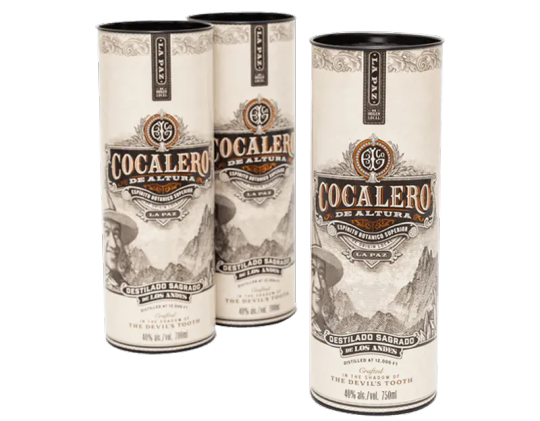
0 notes
Text
Importer of Record Responsibilities: A Comprehensive Guide

The role of an Importer of Record Responsibilities (IOR) is pivotal in the global supply chain, serving as the responsible entity for ensuring that imported goods comply with all legal and regulatory requirements in the destination country. This responsibility is not merely procedural but also holds significant legal and financial implications. In this guide, we delve into the various responsibilities of an IOR, providing businesses with the essential knowledge to navigate international trade with confidence.
Who is the Importer of Record (IOR)?
The Importer of Record is an individual or entity designated to take responsibility for the importation of goods into a specific country. This role typically involves ensuring compliance with customs regulations, paying applicable taxes and duties, and providing accurate documentation. The IOR can be the buyer, seller, or a third-party organization authorized to handle these responsibilities.
Key Responsibilities of an Importer of Record
The IOR's duties encompass a range of activities that ensure smooth and compliant import operations. Here’s a breakdown of the primary responsibilities:
1. Legal and Regulatory Compliance
The IOR is responsible for adhering to all import regulations of the destination country. This includes:
Customs Laws: Ensuring that imported goods meet the legal requirements set by the customs authorities.
Trade Compliance: Abiding by international trade laws, including sanctions, export controls, and embargoes.
Product Regulations: Verifying that the goods comply with local standards, such as safety, quality, and labeling requirements.
Failure to comply can result in fines, delays, or even confiscation of goods.
2. Documentation Management
Accurate documentation is critical for the importation process. The IOR must ensure that all required documents are complete and submitted to the relevant authorities. Key documents include:
Commercial Invoice: Provides details about the goods, their value, and terms of sale.
Bill of Lading or Air Waybill: Acts as a receipt of shipment and evidence of the contract between the exporter and carrier.
Packing List: Details the contents of the shipment for customs inspection.
Import Licenses: If required, these must be obtained and presented.
Certificates of Origin: Confirm the goods' country of manufacture, often necessary for tariff classification.
3. Payment of Duties and Taxes
One of the fundamental responsibilities of the IOR is to pay all duties, taxes, and fees associated with the importation of goods. This may include:
Customs Duties: Calculated based on the classification and value of the goods.
Value-Added Tax (VAT): Applied in many countries to imported goods.
Excise Taxes: Specific to certain products, such as alcohol, tobacco, and luxury items.
Timely payment ensures that goods are not delayed or held at customs.
4. Product Classification and Tariff Codes
Correctly classifying goods under the Harmonized System (HS) codes is another vital responsibility. These codes determine the duties and taxes applicable to the shipment. Errors in classification can lead to:
Overpayment or underpayment of duties.
Delays in customs clearance.
Potential penalties for non-compliance.
5. Ensuring Proper Markings and Labeling
Imported goods must meet the labeling requirements of the destination country. This can include:
Product Labels: Information such as origin, safety warnings, and ingredients.
Packaging Standards: Ensuring materials comply with environmental or safety regulations.
Failure to comply with labeling standards can result in fines or rejected shipments.
6. Managing Import Licenses and Permits
Certain products, such as pharmaceuticals, electronics, and food items, may require special permits or licenses. The IOR is responsible for:
Obtaining the necessary permits before shipment.
Ensuring all additional regulatory requirements are fulfilled.
7. Acting as a Liaison with Customs Authorities
The IOR serves as the primary point of contact between the customs authorities and the business. This involves:
Answering queries from customs officials.
Providing additional documentation or information as needed.
Resolving disputes or issues that arise during the clearance process.
8. Record-Keeping and Audit Readiness
Customs authorities may audit import transactions to ensure compliance. The IOR must maintain detailed records of all imports, including:
Copies of all documentation submitted.
Proof of payment for duties and taxes.
Records of any correspondence with customs authorities.
Typically, records must be kept for a specified period, often five years or more, depending on local regulations.
Risks and Challenges for the Importer of Record
While the responsibilities of an IOR are clearly defined, the role comes with inherent challenges, such as:
Regulatory Changes: Keeping up with evolving import regulations in different countries.
Financial Liability: The IOR bears financial responsibility for duties, taxes, and penalties.
Operational Complexity: Managing multiple shipments and varying documentation requirements.
Legal Risks: Non-compliance can lead to legal action, fines, and damage to reputation.
To mitigate these risks, many businesses partner with experienced third-party IOR service providers.
The Role of IOR Service Providers
Engaging a professional IOR service provider can streamline the import process, especially for businesses entering new markets. These providers offer:
Expertise in local regulations and requirements.
Assistance with documentation, permits, and licenses.
Efficient handling of customs clearance and payment processes.
By outsourcing IOR responsibilities, businesses can focus on core operations while ensuring compliance and minimizing risks.
Conclusion
The Importer of Record plays a critical role in international trade, serving as the linchpin for compliance, documentation, and financial accountability. Whether acting independently or through a trusted service provider, the IOR’s responsibilities ensure that goods move smoothly through customs and reach their destination without legal or operational hiccups.
For businesses involved in global trade, understanding and fulfilling IOR duties is essential for sustained success in the international marketplace.
0 notes
Text
WPC Extrusion Mould For WPC Door Board
WPC extrusion line mould for kinds of WPC door board production, for example, PE WPC door board mould, PP WPC door board mould and PVC WPC door board mould, hollow or solid WPC mould design is available. The mould size and shape can be customized.
Mould Name: WPC door board extrusion mould
HS code: 8480790090
Mould component: die head, calibrator, water cooling tank ,heater
Die head steel: 3Cr17MoNIVEA
Calibrator steel: 3Cr17
Water cooling tank: stainless steel type
Heater: cast-aluminium
Other Accessories: removable location pins, detachable thread insets, etc.
Other mould steel type for choice: 3Cr13, 3Cr17, 3Cr17MoNiV, din1.2316
Mould cavity: one or multiple cavity by the real mould section design.
Mould surface treatment: Mirror Polish
Production machine: CNC
Extrusion speed: 0.2-2m/min
After-sale service: dispatch engineer to customer’s factory for mould commissioning and training.
Value-added service: material formula guidance for improving and optimizing.
Package: Wood /Plywood case(standard export packing)
Lead time: 20 to 30 working days after down payment
Production ability:100 sets of mould per month
Export to: Europe, Middle East, South America, North America, Asia, Africa etc.
Features
Advantage of WPC door board extrusion mould in MG Machinery:
1, high quality mould steel.
2, professional mould design engineer can meet different customized requirements.
3, skilled workers with good technic level for mould making.
4, CNC for precision mould manufacturing.
5, professional mould design engineer can meet different customized requirements.
6, mature team for material formula design and mould commissioning.
7, dispatch engineer quickly.
8, delivery moulds on time.


Main Techincal Parameter
WPC door board extrusion moulds, you can choose the exist model from our product list, or we will make the moulds by your sizes and shape design.

Advantage
Available plastic extrusion mould in MG machinery:
1)Mould for non-foam PE WPC, PP WPC, PVC WPC profiles;
2)Mould for WPC co-extrusion;
3)Mould for PVC+ wood powder surface crusting foaming profile;
4)Mould for PVC low foaming profile, co-extrusion mould for PVC foam decoration profile;
5)Mould for hard PVC door, door panels;
6)mould of color co-extrusion and soft-hard co-extrusion ;
7) Co-extrusion mould for steel-plastic and aluminum-plastic composite;
8) Colors co-extrusion mould for board, wire duct;
9) Mould for PVC quick assembling wallboard;
10) Mould for imitation marble line, door line and water bar.
In conclusion, the WPC Extrusion Mould for WPC Door Board from machinemg.com offers a highly efficient and durable solution for manufacturers looking to produce high-quality WPC door boards. With precision engineering, advanced technology, and a robust design, this mould ensures consistent performance, helping manufacturers meet the growing demand for environmentally friendly, versatile, and long-lasting wood-plastic composite (WPC) products. Whether for large-scale production or customized requirements, this extrusion mould enhances the overall productivity and quality of WPC door board manufacturing, making it an ideal investment for businesses in the industry.
#waste shredder machine#wpc machine#plastic recycling washing machines#pet bottle washing line#wpc extrusion line#plastic crusher machine
0 notes